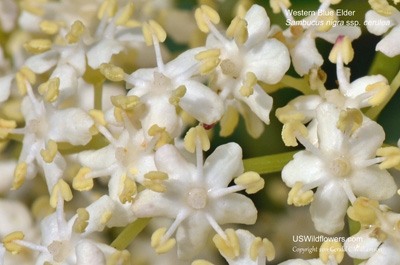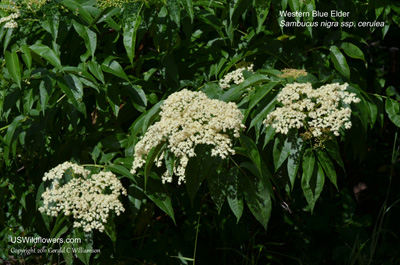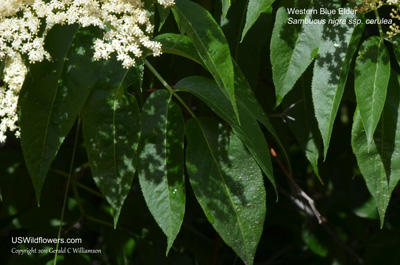Wildflowers of the United States | |||||||||||||
| |||||||||||||
Sambucus nigra ssp cerulea - Western Blue Elder, Blue Elderberry. Western Blue Elder is a shrub or small tree that grows up to 25 feet tall and may have many stems, forming dense thickets. The leaves are pinnate, with usually 3 to 9 lanceolate, serrated leaflets. The plant has large cymes of small white flowers which will produce blue berries in late summer which can be used in jams and to make wine, although the raw berries in large quantities may be poisonous. The unripe berries, the stems, and the leaves may be poisonous.
| It was formerly classified as the separate species Sambucus cerulea. Another subspecies, S. nigra ssp. canadensis (formerly S. canadensis, and these plants are still treated as separate species in the esteemed Weakley's Flora of the Southern and Mid-Atlantic States) is known as the Black Elderberry. Recent classification changes have also moved the genus Sambucus, along with Viburnum, out of the Honeysuckle Family and into the Muskroot Family. This subspecies of the Sambucus nigra is not as widespread as ssp. canadensis, Black Elderberry. Sambucus nigra ssp. cerulea is found in 12 western states. The color of the berries is the most sure way to tell the difference if you are in the 7 states where you may find either species - Montana, Colorado, Wyoming, Texas, New Mexico, Arizona, and California. Sambucus nigra ssp. cerulea may be taller - it can reach 25 feet in height - and may have as few as 3 leaflets, while Sambucus nigra ssp. canadensis usually is rarely taller than 10 feet, and will usually have a minimum of 5 leaflets. Found in: AZ, CA, CO, ID, MT, NM, NV, OR, TX, UT, WA, WY Leave comments on Sambucus nigra ssp cerulea at this link.   Blue=Native; Grey=Introduced Map from USDA Plants Database: USDA, NRCS. 2017. The PLANTS Database (http://plants.usda.gov, 03 Apr 2025). National Plant Data Team, Greensboro, NC 27401-4901 USA. Search Our Database: Enter any portion of the Scientific, Common Name, or both. Do a general Google search of the entire site: #ad
| #ad
| | ||||||||||
|
Commercial / Cookie Notice Looking for Wildflowers for a specific state? Check here: | |||||||||||||
|
| |||||||||||||




